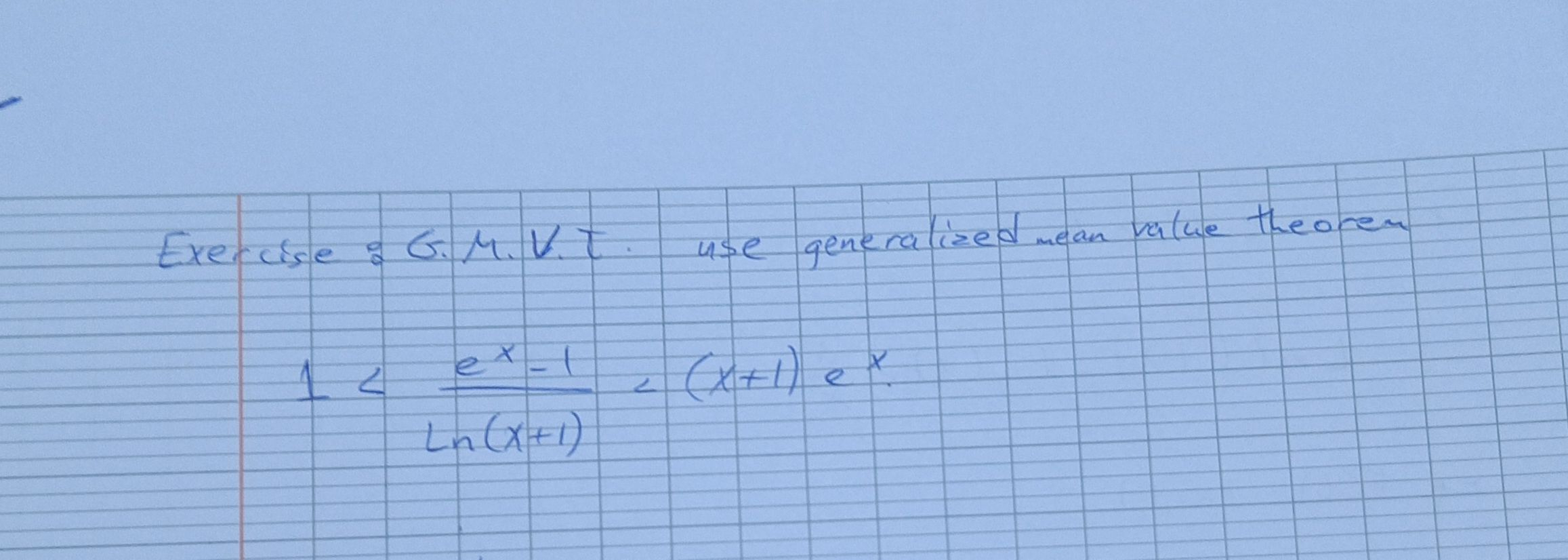AI tutor
Welcome to Bytelearn!
Let’s check out your problem:

Exercise: G.M.V.T. use generalized mean value theorem 1<\frac{e^{x}-1}{\ln (x+1)}<(x+1) e^{x}
Full solution
Q. Exercise: G.M.V.T. use generalized mean value theorem
- Understand GMVT: Let's first understand the Generalized Mean Value Theorem (GMVT). The GMVT states that if functions and are continuous on and differentiable on , then there exists some in such that . We will apply this theorem to the functions and on the interval for .
- Check Functions: First, we need to check that and are continuous on and differentiable on . The function is continuous and differentiable everywhere, and so is . The function is continuous and differentiable for x > -1, which includes our interval since x > 0. Therefore, both and satisfy the conditions for the GMVT.
- Find Derivatives: Now, we will find the derivatives of and . The derivative of is . The derivative of is .
- Apply GMVT: Applying the GMVT, there exists some in such that . Substituting the functions and their derivatives, we get:.Simplifying, we have:.
- Analyze Inequalities: Since is in , we know that 0 < c < x. Therefore, e^c < e^x because the exponential function is increasing. Also, c + 1 < x + 1 for the same reason. Multiplying these two inequalities, we get e^c \cdot (c + 1) < e^x \cdot (x + 1).
- Show Positivity: From the previous step, we have . Since e^c * (c + 1) < e^x * (x + 1), we can say that (e^x - 1) / \ln(x + 1) < e^x * (x + 1).
- Consider Function : Now we need to show that 1 < \frac{e^x - 1}{\ln(x + 1)}. We know that is always greater than for x > 0, so is positive. Since is also positive for x > 0, the fraction is positive. We need to show that it is greater than .
- Use Derivative of : Consider the function . Its derivative is . Since e^x > 1 for x > 0, h'(x) > 0, which means is increasing for x > 0. Since , for x > 0, we have , which means , or .
- Combine Results: Since e^x - 1 > x, we can divide both sides by (which is positive for x > 0) to get (e^x - 1) / \ln(x + 1) > x / \ln(x + 1). Since the function approaches as approaches from the right, and is increasing for x > 0, we have x / \ln(x + 1) > 1 for x > 0. Therefore, .
- Combine Results: Since e^x - 1 > x, we can divide both sides by (which is positive for x > 0) to get (e^x - 1) / \ln(x + 1) > x / \ln(x + 1). Since the function approaches as approaches from the right, and is increasing for x > 0, we have x / \ln(x + 1) > 1 for x > 0. Therefore, . Combining the results from the previous steps, we have shown that for x > 0, which is what we wanted to prove using the Generalized Mean Value Theorem.
More problems from Evaluate expression when two complex numbers are given
QuestionGet tutor help
QuestionGet tutor help
